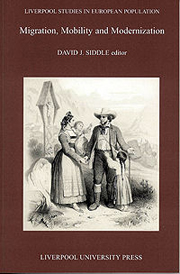Book contents
- Frontmatter
- Contents
- List of Figures
- List of Tables
- 1 Introduction
- 2 Nephews, Dowries, Sons and Mothers: the Geography of Farm and Marital Transactions in Eastern Ireland, c. 1820–c.1970
- 3 Mobility, Kinship and Commerce in the Alps, 1500–1800
- 4 People from the Pits: the Origins of Colliers in Eighteenth-Century South-West Lancashire
- 5 Motives to Move: Reconstructing Individual Migration Histories in early Eighteenth-Century Liverpool
- 6 Urban Population and Female Labour: the Fortunes of Women Workers in Rheims before the Industrial Revolution
- 7 Mobility Among Women in Nineteenth-Century Dublin
- 8 Tramping Artisans in Nineteenth-Century Vienna
- 9 Migration and Urbanization in North-West England: a Reassessment of the Role of Towns in the Migration Process
- Index
3 - Mobility, Kinship and Commerce in the Alps, 1500–1800
- Frontmatter
- Contents
- List of Figures
- List of Tables
- 1 Introduction
- 2 Nephews, Dowries, Sons and Mothers: the Geography of Farm and Marital Transactions in Eastern Ireland, c. 1820–c.1970
- 3 Mobility, Kinship and Commerce in the Alps, 1500–1800
- 4 People from the Pits: the Origins of Colliers in Eighteenth-Century South-West Lancashire
- 5 Motives to Move: Reconstructing Individual Migration Histories in early Eighteenth-Century Liverpool
- 6 Urban Population and Female Labour: the Fortunes of Women Workers in Rheims before the Industrial Revolution
- 7 Mobility Among Women in Nineteenth-Century Dublin
- 8 Tramping Artisans in Nineteenth-Century Vienna
- 9 Migration and Urbanization in North-West England: a Reassessment of the Role of Towns in the Migration Process
- Index
Summary
A well-known characteristic of the mountain regions of southern Europe in the preindustrial period was the regular movement of young migrants who left each winter to seek work in the lowlands and returned in the spring as the snows melted. This response became an established and lasting feature of the economies of upland areas from the period of demographic recovery following the Black Death. For most scholars the iconography of such movement helped to define the human ecology of mountain areas. In conditions closest to the margins of existence, the main function of such migration, it seemed, was to ease the pressure on subsistence – though those returning might be expected to bring back a little capital to help pay taxes (Dupâquier, 1988; Braudel, 1966, pp. 33, 42, 46, 272–74; 1979, pp. 78, 79; 1990, pp. 244, 301, 302, 509, 510; Le Roy Ladurie, 1966, pp. 98–102; Hufton, 1974, p. 72; Poitrineau, 1981; Perrel, 1966; Moch, 1983, pp. 33, 34; Viazzo, 1989, chs 1–6).
Recent demographic research reveals that this regular movement was certainly significant, leaving its mark on the periodicity of marriages and births, as young men left in the autumn and returned again in the spring. In some circumstances it may also have regulated fertility (Maistre and Maistre, 1986, p. 101; Jones, 1990; Reher, 1990, ch. 3). It seems at least reasonable to infer, however, that such seasonal movements were no more than a minor brake on increasing population.
- Type
- Chapter
- Information
- Migration, Mobility and Modernization , pp. 47 - 69Publisher: Liverpool University PressPrint publication year: 2000
- 2
- Cited by



